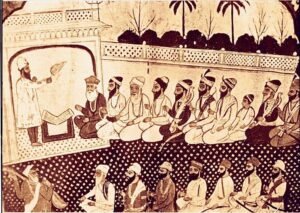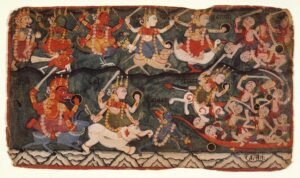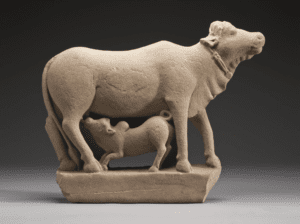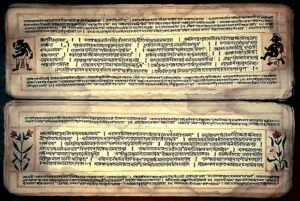
Introduction to Upanishads
The Upanishads are a collection of ancient Hindu texts that form the philosophical foundation of Hinduism. Composed between 800 BCE and 200 BCE, the Upanishads represent a significant shift from the ritualistic practices of the earlier Vedic texts to a deeper exploration of metaphysical concepts and the nature of existence. Often referred to as Vedanta, meaning “the end of the Vedas,” these texts are revered as Shruti (divine revelation) and are considered the culmination of Vedic wisdom.
The Upanishads delve into profound spiritual teachings, offering insights into the nature of the self (Atman), the ultimate reality (Brahman), and the path to liberation (Moksha). This article explores the core concepts, key teachings, and enduring influence of the Upanishads in Hindu philosophy and spirituality.
Historical and Philosophical Context
The Upanishads emerged during the later Vedic period, a time of significant intellectual and spiritual development in ancient India. While the earlier Vedas focused primarily on rituals, sacrifices, and hymns dedicated to the gods, the Upanishads marked a transition towards introspection and philosophical inquiry.
This period saw a growing dissatisfaction with the ritualistic aspects of religion and a desire to understand the deeper meaning of life and the universe. The sages and seers who composed the Upanishads sought to answer fundamental questions about the nature of reality, the self, and the purpose of human existence.

The teachings of the Upanishads are presented in the form of dialogues, stories, and discourses between teachers and students, often set in forest hermitages where spiritual knowledge was imparted. These texts emphasize direct experience, self-inquiry, and the realization of one’s true nature as pathways to spiritual liberation.
Core Concepts of the Upanishads
The Upanishads introduce several key concepts that have become central to Hindu philosophy:
- Atman: Atman refers to the individual soul or self, which is considered eternal and unchanging. According to the Upanishads, the Atman is the true essence of every being and is identical with Brahman, the ultimate reality. The realization of the Atman as one’s true self is the key to achieving Moksha, or liberation from the cycle of birth and death.
- Brahman: Brahman is the supreme, unchanging reality that pervades the entire universe. It is described as infinite, formless, and beyond human comprehension. The Upanishads teach that Brahman is the source of all creation and that everything in the universe is a manifestation of Brahman. The ultimate goal of spiritual practice is to realize the unity of Atman and Brahman.
- Maya: Maya refers to the illusion or appearance of the material world, which conceals the true nature of reality. According to the Upanishads, the world as we perceive it is an illusion created by Maya, and it is only through spiritual knowledge and self-realization that one can see beyond this illusion and perceive the truth of Brahman.
- Moksha: Moksha is the liberation from the cycle of Samsara (birth, death, and rebirth) and the realization of one’s true nature as Atman. The Upanishads teach that Moksha is achieved through the direct knowledge of Brahman and the dissolution of the ego. It represents the ultimate goal of human life and the attainment of eternal peace and bliss.
Key Upanishads and Their Teachings
Among the 108 Upanishads, a few are particularly significant for their philosophical depth and influence:
- Chandogya Upanishad: This Upanishad is known for its teachings on the sacred syllable Om, which is considered the sound representation of Brahman. The Chandogya Upanishad explores the nature of reality and the importance of meditation as a means of realizing the self.
- Katha Upanishad: The Katha Upanishad is a dialogue between the young seeker Nachiketa and Yama, the god of death. Through this dialogue, the Upanishad explores the nature of the self, the impermanence of the material world, and the path to immortality. It is in this Upanishad that the famous teaching “The self is not born, nor does it die” is found.
- Mundaka Upanishad: The Mundaka Upanishad distinguishes between higher knowledge (Para Vidya), which leads to the realization of Brahman, and lower knowledge (Apara Vidya), which pertains to the material world. It emphasizes the importance of spiritual wisdom and the renunciation of worldly attachments as the path to liberation.
- Mandukya Upanishad: This brief but profound Upanishad is known for its analysis of the states of consciousness: waking (Jagrat), dreaming (Swapna), deep sleep (Sushupti), and the fourth state, Turiya, which represents pure consciousness and the realization of Brahman. The Mandukya Upanishad is highly regarded in the Advaita Vedanta tradition for its concise and direct teachings on the nature of the self.
Influence on Hindu Philosophy and Practices
The Upanishads have had a profound influence on the development of Hindu philosophy, particularly the Vedanta school, which is based on their teachings. Advaita Vedanta, propounded by the philosopher Adi Shankaracharya, draws heavily on the Upanishads’ teachings on non-dualism (Advaita) and the unity of Atman and Brahman.
The concepts of Atman, Brahman, and Maya introduced in the Upanishads have also shaped Hindu practices such as meditation, self-inquiry, and the pursuit of spiritual knowledge. These texts continue to be studied and revered by spiritual seekers and scholars alike, and their teachings have inspired various movements within Hinduism, as well as other spiritual traditions around the world.
Conclusion
The Upanishads represent the culmination of Vedic thought and offer profound insights into the nature of existence, the self, and the ultimate reality. Their teachings on Atman, Brahman, and Moksha have become the cornerstone of Hindu philosophy and continue to inspire spiritual exploration and self-realization.
As timeless guides to the mysteries of life and the universe, the Upanishads remain relevant today, providing a pathway for those seeking to transcend the limitations of the material world and realize their true nature. Their wisdom continues to resonate across cultures and generations, making them one of the most important and influential texts in the history of world spirituality.






